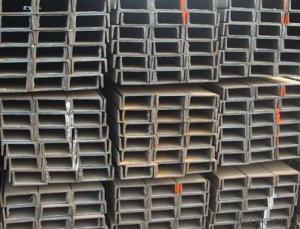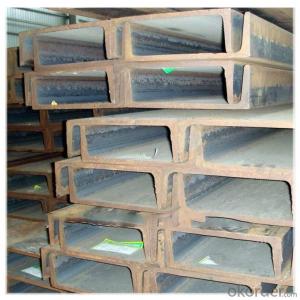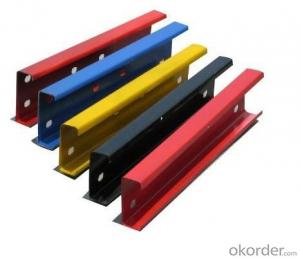channel steel Surface and Length: According to the Requirements
- Loading Port:
- Qingdao
- Payment Terms:
- TT OR LC
- Min Order Qty:
- 15 m.t.
- Supply Capability:
- 500000 m.t./month
OKorder Service Pledge
OKorder Financial Service
You Might Also Like
1、the details information of our Channel Steel
1)the ordinary model
Height: | 90-400mm |
Thickness: | 9-14.5mm |
Surface: | according to the customers’ requirements |
Length: | As customers’ requirements |
Size: | 90*37*4.5mm--400*104*14.5 mm . |
Punch: | Can be punched as customer's drawing |
Material: | Q195/Q235/ Q215/Q345/SS400/S235JR, A36,SS400,SS540 ASTM A36 and so on |
2)the light model
Height: | 90-400mm |
Thickness: | 6.4-8.0mm |
Surface: | Painted or Galvanized;according to the customers’ requirements |
Length: | As customers’ requirements |
Size: | 50*32*4.4mm--400*115*8.0mm . |
Punch: | Can be punched as customer's drawing |
Material: | Q195/Q235/ Q215/Q345/SS400/S235JR, A36,SS400,SS540 ASTM A36 and so on |
2、the Product Advantage
1) We can design the channel steel according to customers’requirements
2) We can manufacture under complete quality control system---ISO9001&SGS
3) We can installed with instruction of experienced engineers
4) Easy to assemble and dismantle
5) Eco-friendly material: can be used for several times and can be recycled
6) Shorter construction period, longer using time
7) High strength and stiffness, high weight bearing
3、why choose us ?Product Advantage
1)The channel steel quality is prime quality
2)Our price is competitive price with our competitor
3)We provide the professional service
4)Prompt delivery & Seaworthy packing
5)Mill Test Certificate
- Q: Are steel channels suitable for high-temperature applications?
- Steel channels are generally suitable for high-temperature applications. Steel is known for its strength and ability to withstand high temperatures without losing its structural integrity. However, the suitability of steel channels for high-temperature applications depends on various factors such as the grade of steel used, the specific temperature range, and the duration of exposure to high temperatures. Certain grades of steel, such as stainless steel, are particularly well-suited for high-temperature applications due to their high resistance to corrosion and oxidation. Stainless steel channels are commonly used in industries such as automotive, aerospace, and chemical processing, where they are exposed to elevated temperatures. It is important to consider the specific temperature range when determining the suitability of steel channels for high-temperature applications. Steel begins to lose its strength and structural integrity at higher temperatures. Therefore, it is crucial to select a grade of steel that can withstand the desired temperature range without compromising its performance. Another factor to consider is the duration of exposure to high temperatures. Prolonged exposure to high temperatures can cause steel to undergo structural changes, such as softening or distortion. It is essential to ensure that the steel channels used in high-temperature applications are designed to withstand the expected duration of exposure without any significant deterioration. In summary, steel channels can generally be considered suitable for high-temperature applications. However, it is crucial to select the appropriate grade of steel, consider the specific temperature range, and evaluate the duration of exposure to ensure the desired performance and structural integrity.
- Q: How do steel channels contribute to the overall stability of a structure?
- Steel channels contribute to the overall stability of a structure by providing structural support and reinforcement. They are often used as beams or columns, distributing the load and transferring it to the foundation or other supporting elements. Their shape and material properties enhance their strength and stiffness, allowing them to withstand bending, torsion, and other forces that can cause structural instability. Additionally, steel channels can be strategically placed to resist lateral movements and vibrations, ensuring the stability and integrity of the entire structure.
- Q: What are the different types of accessories available for steel channels?
- Steel channels have a variety of accessories that serve specific purposes and enhance their functionality. Some common accessories include: 1. Brackets: Used for additional support, especially when the channels are installed vertically or at an angle. Brackets maintain structural integrity and prevent sagging or bending. 2. End Caps: Cover the ends of channels for a clean and finished appearance. They also protect the edges from corrosion, moisture, and external elements. 3. Connectors: Join two or more channels together. Available in different shapes and sizes, such as straight, angle, and T-connectors, made of metal for a strong connection. 4. Mounting Hardware: Includes screws, bolts, and nuts to securely fasten channels to surfaces or structures, ensuring they can withstand intended loads. 5. Sliding Trolleys: Used when channels need to support movable loads or equipment. Allows smooth and easy movement along the channels for flexibility and convenience. 6. Cable Management Accessories: Facilitate cable management within channels. Examples include cable clamps, ties, trays, and routing fittings. Organize and secure cables for an efficient system. 7. Hangers and Supports: Used to suspend or hang channels from ceilings, walls, or other structures. Provide stability, especially for heavy loads. 8. Protective Coatings: Not accessories per se, but essential for enhancing durability and resistance to corrosion. Galvanization or powder coating protects against rust, moisture, and environmental factors. These are just a few examples of the accessories available for steel channels. Depending on specific applications, there may be additional accessories or variations to optimize performance and functionality.
- Q: Can steel channels be used in high-temperature environments?
- Yes, steel channels can be used in high-temperature environments. Steel is a highly durable and heat-resistant material that can withstand high temperatures without losing its structural integrity. It has a high melting point and does not deform or weaken easily under extreme heat conditions. Steel channels are often used in industrial applications such as furnaces, boilers, and high-temperature processing equipment. However, it is important to consider the specific grade of steel being used, as certain types may have limitations in terms of temperature resistance. Additionally, factors such as the duration and frequency of exposure to high temperatures should also be taken into account when determining the suitability of steel channels for a particular high-temperature environment.
- Q: What direction does channel steel use best?
- The ability of the channel to bear the vertical load is proportional to its vertical cross section, so the opening is left or right, and the maximum vertical load can be carried.
- Q: Large steel channel used for steel structural staircases
- Standard Specification for channel steel is C250*78*6TThe rest are flat steel strips and checkered steel plates
- Q: Can steel channels be used in the telecommunications industry?
- Yes, steel channels can be used in the telecommunications industry. Steel channels are commonly used as cable trays and support systems for telecommunications cables. They provide a sturdy framework for routing and organizing cables, ensuring proper cable management and preventing damage. Additionally, steel channels are known for their durability and strength, making them suitable for withstanding the weight of heavy cables and equipment. They can also be easily customized and modified to accommodate specific requirements in the telecommunications industry. Overall, steel channels offer a reliable and cost-effective solution for cable management in the telecommunications sector.
- Q: What does "channel weight" mean?
- The channel is simply an ideal state of the weight is from the drawing to calculate the weight of steel, but after hot rolling, the size of the actual size and always on the drawings of the deviation, and generally less than the actual weight of theoretical weight.
- Q: Can steel channels be used for walkway supports?
- Indeed, walkway supports can utilize steel channels. Renowned as C-channels, steel channels are frequently employed in the construction industry due to their robustness and endurance. By offering a steady and dependable support framework, they guarantee the safety of pedestrians utilizing walkways. Effortless to install and capable of enduring substantial burdens and continuous foot traffic, steel channels emerge as an optimal selection for walkway supports in diverse environments, including industrial plants, bridges, and outdoor walkways.
- Q: How do steel channels contribute to building aesthetics?
- Building aesthetics can be enhanced in several ways by incorporating steel channels. Firstly, these channels serve as structural elements, providing strength and stability to the overall structure. However, they also play a significant role in improving the visual appeal of a building. One of the primary ways steel channels contribute to building aesthetics is through their sleek and contemporary appearance. With their clean lines and smooth surface, steel channels can give a building a modern and sophisticated look. They can be utilized in a range of architectural designs, from industrial to minimalist, adding a touch of elegance and refinement to the overall aesthetic. Furthermore, steel channels offer great versatility in terms of design possibilities. Architects and designers can easily customize and fabricate them into various shapes and sizes, allowing for the creation of unique and visually striking elements. Steel channels can be employed as decorative features like handrails, balustrades, or window frames, thereby adding visual interest and architectural detailing to the building. Moreover, steel channels can be finished with different coatings or treatments to further enhance their aesthetic appeal. They can be painted in various colors to complement the overall design scheme or left exposed, showcasing the natural beauty of steel. Additionally, they can be polished or brushed to achieve different textures and finishes, thereby adding depth and character to the building's appearance. Furthermore, steel channels can contribute to the aesthetics of a building by creating a sense of openness and transparency. When used as structural elements in facades, they can support large glass panels, allowing for expansive views and the entry of natural light into the building. This creates a visually pleasing and inviting atmosphere, connecting the interior spaces with the surrounding environment. In conclusion, steel channels enhance building aesthetics by providing a sleek and contemporary appearance, offering design versatility, enabling customization, and creating a sense of openness. With their clean lines, smooth surface, and various finishing options, steel channels can elevate the visual appeal of a building, adding elegance, sophistication, and architectural detailing to the overall design.
Send your message to us
channel steel Surface and Length: According to the Requirements
- Loading Port:
- Qingdao
- Payment Terms:
- TT OR LC
- Min Order Qty:
- 15 m.t.
- Supply Capability:
- 500000 m.t./month
OKorder Service Pledge
OKorder Financial Service
Similar products
Hot products
Hot Searches
Related keywords




























